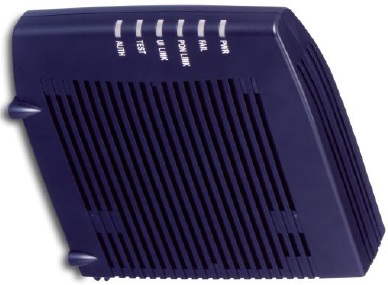Complete introduction of GPON (Gigabit Passive Optical Network): We know GPON stand for Gigabit Passive Optical Network. The main characteristic of GPON is the use of passive splitter in the fiber distribution network, enabling one single feeding fiber from the provider to serve multiple homes and small businesses. GPON emerge through various PON techniques such as APON & BPON and is finally standardize by IEEE & ITU.
GPON has only passive optical components in the access network. Active components are only installed in the central office (Optical Line Terminal, OLT) and at the customer premises (Optical Network Terminals, ONT).Between OLT and ONT is the passive optical network, comprising fiber links, passive splitters and connectors.
Benefits of using GPON technology
GPON technology provide the high bandwidth capacity close to the user. It Supports multiple advanced services for revenue growth. GPON technology provide long reach without amplification.It has no active electronics in OSP equipment and Long physical and economic lifetime. GPON technology provide easy installation & upgrade also fast & quick deployment. It allows small diameter & light weight cables thus small space occupancy. It also secure & immune to electromagnetic interference.
In FTTH network GPON topology has a Feeder (primary) and Distribution (secondary) network, a Fiber Distribution Terminal (Cross connect cabinet), Fiber Access Terminal (Distribution Point) and Drop fibers (service wires).
GPON Network Components
The main components in FTTH network are:
1- Optical Line Terminal 2- Fiber Distribution Frame 3- Passive Optical Splitter 4- Fiber Distribution Terminal/ Hub 5- Fiber Access Terminal 6- Fiber Terminal Box 7- Fiber Outlet Box 8- Access Terminal Box 9- Optical Network Terminal 10- Optical Distribution Box. Below I will explain only main points. If you would like to read more details please open READ MORE
OLT – Optical Line Terminal
I have already mentioned above that it is the central office equipment. It has Interfaces with IP/MPLS, NGN, IMS, IPTV server or others.Each GPON port feeds 64 customers maximum. 8 PORTs GPON cards (each port feeds 64 customers). The OLTs have 16 cards depending on the vendor. Old OLTs installed before 2012 may have 14 or 16 cards with 4 GPON ports / card.
Optical Splitters
The splitters are passive devices which divide the optical signals equally in the ratio of 1:2 to 1:64, introducing optical loss depending on the splitting ratio. This ratio is determined by the network topology as described in this document for the different OSP scenarios.
The splitters may be located in central office besides the OLT (in ODF or FDF), inside the Fiber Distribution Terminal (FDT) outdoor/indoor, in enclosures, in Fibre Access Terminals and even in Manholes and Handholes. They can also be installed in a building in case of Multi Dwelling Units (MDU) in an OSB.
Every time the signal is split in two, half the power goes one way and half goes the other. So each direction gets half the power, or the signal is reduced by: 10 log (0.5) = 3 dB.
Practical loss is 3.5 dB nominal, so every 1:2 split costs about 10 km distance at 1330 nm.
Splitter modules are provided pre-connectorized, with pigtail at the outputs and input. The splitter input may also be spliced to the feeder cable in the ODF.
Optical Distribution Frame (ODF)
It Provide interface/cross connect facility between ISP & OSP.Feeder cable termination at central office (ODF Sizes are 24F/48F/72F/96F/144F) for FTTH termination we are using ODF of 72/96/144 ports.
Fiber Distribution Terminal (FDT/FDH) (Indoor)
The indoor FDT is designed to organize and administer fiber optic cables and passive optical splitters in an indoor environment, typically suitable for high rise buildings and are placed in the telecom Room (CER).
It accommodates multiple splitters of 1:32 or 2:32 split ratio in a standard ETSI Rack.It accommodates ODF trays of 24/48 ports per RU. ODFs terminate and patch the splitters outputs and all the block wiring from floors of high rise buildings.
Fiber Distribution Terminal (FDT/FDH) – Outdoor
The FDT is placed strategically in the FTTH network to facilitate service connection specified for a particular fiber serving area. It gives a flexibility point for fiber cables to achieve maximum utilization of the ISP and ODN resources.
It is scalable according to demand growth in the FDT and OLT area.It accommodates multiple splitters of 1:32 (or 2:32) split ratio.It allows fiber management for Feeder and Distribution cables.The FDT provide environmental and mechanical protection for cables, splices, connectors and passive optical splitters.
Optical Splitter Box-Indoor (OSB)
It aims to extend splitters near to customer for high density parcels.For MDUs a wall mounted unit is suitable for in-building installation where the number of tenancies is more than 16 and up to 32.
Optical Distribution Box (ODB)
The Optical Distribution Box is being used for lower density MDUs.The capacity of each box ranges from 12/24/48/96 fibers.It aims for medium density parcels by utilizing FDT Splitters.
Fiber Termination Box (FTB)
Fiber Termination Box at the entrance of each SFU.It provides the test point for customer connection without entering the premises.LC/APC interface is recommended in line with approved specification.
Fiber Outlet Box (FOB)
Last termination point for fiber in customer premises before ONT.Fiber Optic Socket.
Access Termination Box (ATB)
Last termination point in customer premises if FOB installation is not possible.Alternative to Fiber Optic Socket
Optical Network Terminal – ONT ONT is located directly at the customer's premises. It supports a mixture of telecommunication services.CPE which converts the optical signal to electronic signal.Some of these types are ONT-R, ONT-B, ONT-MDU.Basic Model of ONT comes with two POTS & 2 or 4 Fast Ethernet ports.
ONT are indoor type and installed when the service request is received from customer.The location of the Indoor ONT Distribution Box shall be at a common point, where all the internal conduits meet and the structured cabling system (SCS) in a star topology.The farthest socket shall not exceed 90 M from the ONT.
Fiber Termination & Patching Accessories
All types of fiber cables that are not spliced have to be terminated in an SC/APC or an LC/APC connector, depending on the point in the network that the cable is installed.
Summary
I have discussed approx all GPON network components.Infact GPON enables future upgrade migration without passive Infrastructure replacement.A GPON network is capable of transmitting ethernet, TDM (Time Division Multiplexing) as well as ATM traffic.A GPON network can reach up to 20 km and provide service up to 64 end users.
1- Optical Line Terminal 2- Fiber Distribution Frame 3- Passive Optical Splitter 4- Fiber Distribution Terminal/ Hub 5- Fiber Access Terminal 6- Fiber Terminal Box 7- Fiber Outlet Box 8- Access Terminal Box 9- Optical Network Terminal 10- Optical Distribution Box. Below I will explain only main points. If you would like to read more details please open READ MORE
OLT – Optical Line Terminal
I have already mentioned above that it is the central office equipment. It has Interfaces with IP/MPLS, NGN, IMS, IPTV server or others.Each GPON port feeds 64 customers maximum. 8 PORTs GPON cards (each port feeds 64 customers). The OLTs have 16 cards depending on the vendor. Old OLTs installed before 2012 may have 14 or 16 cards with 4 GPON ports / card.
Optical Splitters
The splitters are passive devices which divide the optical signals equally in the ratio of 1:2 to 1:64, introducing optical loss depending on the splitting ratio. This ratio is determined by the network topology as described in this document for the different OSP scenarios.
The splitters may be located in central office besides the OLT (in ODF or FDF), inside the Fiber Distribution Terminal (FDT) outdoor/indoor, in enclosures, in Fibre Access Terminals and even in Manholes and Handholes. They can also be installed in a building in case of Multi Dwelling Units (MDU) in an OSB.
 |
| maximum split ratio loss |
Every time the signal is split in two, half the power goes one way and half goes the other. So each direction gets half the power, or the signal is reduced by: 10 log (0.5) = 3 dB.
Practical loss is 3.5 dB nominal, so every 1:2 split costs about 10 km distance at 1330 nm.
Splitter modules are provided pre-connectorized, with pigtail at the outputs and input. The splitter input may also be spliced to the feeder cable in the ODF.
Optical Distribution Frame (ODF)
It Provide interface/cross connect facility between ISP & OSP.Feeder cable termination at central office (ODF Sizes are 24F/48F/72F/96F/144F) for FTTH termination we are using ODF of 72/96/144 ports.
Fiber Distribution Terminal (FDT/FDH) (Indoor)
The indoor FDT is designed to organize and administer fiber optic cables and passive optical splitters in an indoor environment, typically suitable for high rise buildings and are placed in the telecom Room (CER).
It accommodates multiple splitters of 1:32 or 2:32 split ratio in a standard ETSI Rack.It accommodates ODF trays of 24/48 ports per RU. ODFs terminate and patch the splitters outputs and all the block wiring from floors of high rise buildings.
Fiber Distribution Terminal (FDT/FDH) – Outdoor
The FDT is placed strategically in the FTTH network to facilitate service connection specified for a particular fiber serving area. It gives a flexibility point for fiber cables to achieve maximum utilization of the ISP and ODN resources.
It is scalable according to demand growth in the FDT and OLT area.It accommodates multiple splitters of 1:32 (or 2:32) split ratio.It allows fiber management for Feeder and Distribution cables.The FDT provide environmental and mechanical protection for cables, splices, connectors and passive optical splitters.
Optical Splitter Box-Indoor (OSB)
 |
| OSB Depending on the Medium Business |
It aims to extend splitters near to customer for high density parcels.For MDUs a wall mounted unit is suitable for in-building installation where the number of tenancies is more than 16 and up to 32.
Optical Distribution Box (ODB)
The Optical Distribution Box is being used for lower density MDUs.The capacity of each box ranges from 12/24/48/96 fibers.It aims for medium density parcels by utilizing FDT Splitters.
Fiber Termination Box (FTB)
 |
| FTB |
Fiber Termination Box at the entrance of each SFU.It provides the test point for customer connection without entering the premises.LC/APC interface is recommended in line with approved specification.
Fiber Outlet Box (FOB)
Last termination point for fiber in customer premises before ONT.Fiber Optic Socket.
Access Termination Box (ATB)
Last termination point in customer premises if FOB installation is not possible.Alternative to Fiber Optic Socket
Optical Network Terminal – ONT ONT is located directly at the customer's premises. It supports a mixture of telecommunication services.CPE which converts the optical signal to electronic signal.Some of these types are ONT-R, ONT-B, ONT-MDU.Basic Model of ONT comes with two POTS & 2 or 4 Fast Ethernet ports.
 |
| ONT |
ONT are indoor type and installed when the service request is received from customer.The location of the Indoor ONT Distribution Box shall be at a common point, where all the internal conduits meet and the structured cabling system (SCS) in a star topology.The farthest socket shall not exceed 90 M from the ONT.
Fiber Termination & Patching Accessories
All types of fiber cables that are not spliced have to be terminated in an SC/APC or an LC/APC connector, depending on the point in the network that the cable is installed.
Summary
I have discussed approx all GPON network components.Infact GPON enables future upgrade migration without passive Infrastructure replacement.A GPON network is capable of transmitting ethernet, TDM (Time Division Multiplexing) as well as ATM traffic.A GPON network can reach up to 20 km and provide service up to 64 end users.





2 Comments
Very useful article for ftth operator.thank you
ReplyDelete3A91C43750
ReplyDeletekiralık hacker
hacker arıyorum
tütün dünyası
-
-